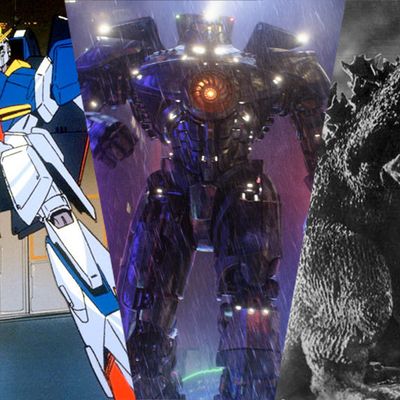
In Guillermo del Toro’s Pacific Rim, humanity creates giant fighting robots (dubbed “Jaegers”) to combat an invasion of gargantuan monsters (known as “Kaiju”) that come from under the sea — a larger-than-life war the Pan’s Labyrinth director constructs from the disparate parts of myriad genre predecessors. From the animal-in-the-city mayhem of King Kong and the eighties monsters-smashing-skyscrapers arcade game Rampage, to the cyborg crime-fighting of Robocop, the robo-punching board game Rock ‘Em Sock ‘Em Robots, and the unholy goliaths of At the Mountains of Madness (the H.P. Lovecraft novella that del Toro has long tried to bring to the screen), the film is a brazen and boisterous summer-spectacular hybrid. Yet more than those aforementioned influences, del Toro’s latest is truly the awesome offspring of the following five source materials, which, in their own distinct ways, can all lay claim to having fathered this monster-and-machine blockbuster.
Mecha Anime
In 1979, the animated TV series Mobile Suit Gundam brought giant robot-fighting mayhem to the Japanese masses, in the process helping to launch one of anime’s defining subgenres. Be it the Gundam franchise (which has spawned a legion of additional TV shows, video games, novels, and manga comic books) or its most popular and influential progeny, Neon Genesis Evangelion, these stories boast hallmarks replicated by Pacific Rim: cocky young heroes who are tasked with controlling anthropomorphic robots through a combination of physical and mental symbiosis; governments that can’t be trusted; paternal figures (both surrogate and literal) who created the robots and help guide the youthful heroes through their quests; and large-scale action — often against invading aliens bent on destruction or colonization — that’s accompanied by romantic, inter-team, and self-actualization-centric melodrama. In addition, victory is always achieved not through firepower might but, rather, through operator ingenuity — thereby making the adventures fundamentally humanistic in nature.
Kaiju Movies
Godzilla, the terror of Tokyo, is an obvious forefather of the creatures in Pacific Rim, which are dubbed “Kaiju,” a Japanese word that roughly means “big monster” and is used to refer to that nation’s giant-beast film genre. Emerging from watery depths to roar with guttural animalistic fury, stomp through one bustling metropolis after another, and spit deadly blasts of something-or-other from their screaming maws, Pac Rim’s fantastical dinosaurs-writ-large are direct descendants of Japan’s most famous monster — as well as foes like Mothra and Rodan, whose physical characteristics (wings, claws, spiked tails) are also found in the many fearsome Kaiju whom heroes Raleigh (Charlie Hunnam) and partner Mako (Rinko Kikuchi) battle. Moreover, Godzilla’s legacy as a radioactive beast intrinsically associated with World War II nuclear fallout is echoed in not only the Jaegers’ nuclear cores, but also in flashbacks to Mako’s traumatic first encounter with a Kaiju in an ashen laid-to-waste Japanese city that more than subtly recalls Hiroshima and Nagasaki.
Hellboy
Pacific Rim is covered in Guillermo del Toro’s idiosyncratic fingerprints and is particularly indebted to the filmmaker’s two sterling adaptations of Mike Mignola’s cult-comic Hellboy. That series’ fondness for dank subterranean sets and locations, often housing secret rooms and unnatural organic specimens housed in glass cases, is replicated in Pacific Rim’s black-market shops as well as in the Jaegers’ Hong Kong Bay HQ, where — also following Hellboy’s lead — nerdy scientists and paranormal experts geek out about possible theories regarding amazing creatures and doomsday scenarios. An early scene in which Idris Elba’s commander gives Raleigh a tour of his new secret-army-base home furthers these echoes, which even extend to the fact that both stories include wounded altruistic father figures. Plus, Pacific Rim features Hellboy’s horned hero himself, Ron Perlman, in a role of typical scene-chewing wise-assery.
Transformers
Sure, Hasbro’s iconic eighties toy line was itself inherently indebted to the mecha anime that preceded it, but Michael Bay’s Transformers movies remain an inescapable influence on del Toro’s film. While the Jaegers’ aesthetic makeup is of a Gundam/Neon Genesis Evangelion sort, their whirring gears and lumbering comportment give the machines a crunching, metal-on-metal physicality that’s more than a tad reminiscent of Bay’s Autobots and Decepticons. If the Jaegers look like cleaner, more coherently designed Transformers, their centerpiece combat scenes against the Kaiju exhibit a fetishism for military hardware, and occasional visual incoherence, that resembles Bay’s films. And the Jaegers’ wanton destruction of entire downtown urban areas, all of them heavily populated with innocent civilians, also carries with it a whiff of Transformers: Dark of the Moon’s nihilistic Chicago-under-siege finale, in that mankind’s saviors don’t seem to bat an eye about causing immense loss-of-life collateral damage in the name of protecting humanity.
Top Gun
True, there are no monsters or robots in Tony Scott’s seminal 1986 fighter-jet actioner. But Pacific Rim still loves it some Tom Cruise flyboy clichés. Like Cruise’s Maverick, Charlie Hunnam’s Raleigh is a hotshot pilot defined by both his good looks and the reckless, breaking-all-the-rules attitude that he’s able to get away with thanks to said handsomeness (and early triumphs born from innate skill). Also like Maverick, Raleigh is wracked by the unexpected death of his partner and best friend while in the line of duty — a tragedy that at least seems partly the by-product of the hero’s own hubris. That Pacific Rim also features a Val Kilmer/Iceman frenemy in the figure of Robert Kazinsky’s Chuck, who initially spars with Raleigh for macho king-of-the-mecha-hill dominance, is thus no surprise, nor is the fact that Raleigh finds ultimate success by becoming one with his war-machine ride. The only things missing are Kelly McGillis and a homoerotic beach volleyball game. Imagine a pair of 250-feet-tall robots playing that.




